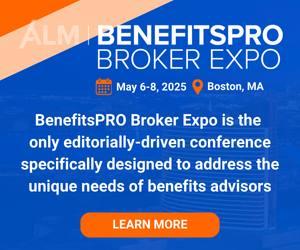
Another open enrollment season is in the books for many employers. While employees may understand the basics of the medical or dental coverages they frequently use, over one-third (38%) admit they don't understand supplemental benefits, like accident, critical illness and hospital cash benefits.
The knowledge gap presents brokers with a strategic opportunity to assist their employer clients in taking an always-on communications approach that enables employees and reinforces the value of supplemental benefits. The Hartford’s 2024 Future of Benefits Study underscores the need for year-round engagement: 74% of U.S. workers reported they want to learn about benefits year-round.
Recommended For You
“Making benefits talk a regular part of the employee conversation can truly make the difference when it comes to benefits understanding and plan utilization,” says Laura Marzi, benefits expert and head of marketing for Group Benefits at The Hartford. “Helping employees understand their full benefits package, including supplemental health benefits, is crucial. Employees may not know how these benefits can boost their medical coverage by helping pay for things even the best medical plans won’t cover.”
Brokers can play a vital role by helping their clients deliver strategic benefits communications aimed at increasing employee understanding and use of their supplemental health benefits. Increased understanding helps to boost employee productivity, satisfaction and loyalty.
Closing the knowledge gap
While 35% of U.S. workers believe benefits education is primarily their employer’s responsibility, 38% report they are equally responsible for building their benefits understanding.
Brokers are uniquely positioned to share supplemental benefit insights and communication best practices to help employers engage their employees year-round.
“Companies of all sizes look to their brokers as trusted, expert advisors when it comes to communication guidance,” says Marzi. “Brokers can play an especially pivotal role in helping mid-size and smaller employers who may not have dedicated resources to implement a year-round communications plan.”
5 keys to year-round benefits engagement
For brokers looking to help their employer clients build a year-round benefits engagement plan, here are five ideas to share:
1. Map out a year-round calendar
Take a year-round approach to benefits communication by creating distinct "mini-campaigns” throughout the year. Choose a theme each month or quarter, such as a coverage need or specific product. For example, highlight accident insurance by showcasing examples of real-life claims or how employees have put their benefits to work.
Deliver your messages through a mix of channels, including email, collaboration tools, text messages, social media, video, handouts and in-person engagement, to accommodate communication preferences and the needs of remote and onsite workers. Having a balanced and inclusive approach ensures messages reach employees at their desks, at home and on the go.
2. Use plain language
Benefits come with complex terms and jargon. Craft communications that use clear language, direct headlines, bulleted lists and FAQ formats to help employees understand information about their coverage the first time they read it. Bolster understanding – and utilization – by sharing examples of when and how to use different benefits.
“Look for opportunities to help employees connect the dots between supplemental health benefits and medical insurance,” suggests Marzi. “Group these coverages together during enrollment and through ongoing communications to highlight how the cash benefits provided by supplemental products can fill gaps left by medical insurance after a covered illness or injury.”
3. Engage with storytelling
Benefits education doesn’t have to be boring. Use storytelling to bring the value of benefits to life and demystify how they work. For example, a real-life story about how critical illness insurance benefits alleviated financial pressures for an employee dealing with a difficult diagnosis can better convey how this coverage works and is more effective than a traditional description.
Another example is sharing a first-person account of how an employee accessed their accident benefits to help pay for out-of-pocket expenses after their child suffered a sports injury, which can emphasize the simplicity of the claims process better than step-by-step instructions.
4. Encourage conversation
Take advantage of two-way internal communication channels through available collaboration tools so employees are part of the conversation. By establishing dedicated benefit-focused community spaces on these platforms, employers can create a real-time resource for employees to ask questions, provide recommendations and share experiences with their peers.
Brokers can help employees facilitate this type of bottoms-up benefits communication by suggesting prompts to spark discussion. Ideas for prompts can range from asking employees what surprised them most about a benefit to a friendly quiz competition featuring name-that-benefit questions.
5. Check in regularly
With always-on communication as the driver, brokers should schedule quarterly check-ins with clients to get updates on the communication plan’s progress and share engagement trends and best practices. Regular conversations provide the opportunity to fine-tune strategies, discuss emerging employee benefit needs and strengthen broker-client relationships.
Always-on results
While enrollment season is over for many employers, employees still need information about making the most of their supplemental health benefits. Brokers can fill the need by helping their clients implement always-on communication strategies. The results are a win-win-win. Knowledgeable, engaged employees are better equipped to take control of their health, financial and overall well-being. Employers see tangible results in employee engagement, satisfaction and loyalty. And brokers expand their client relationships beyond products and pricing.
Get more insights from The Hartford on the Broker Resource Center.
Ann Clifford is a freelance writer who translates her background in financial services marketing into specialized content focused on employee benefits and small business topics.
© 2024 by The Hartford. Classification: Non-Confidential. No part of this document may be reproduced, published, or used without the permission of The Hartford.
© 2025 ALM Global, LLC, All Rights Reserved. Request academic re-use from www.copyright.com. All other uses, submit a request to [email protected]. For more information visit Asset & Logo Licensing.








